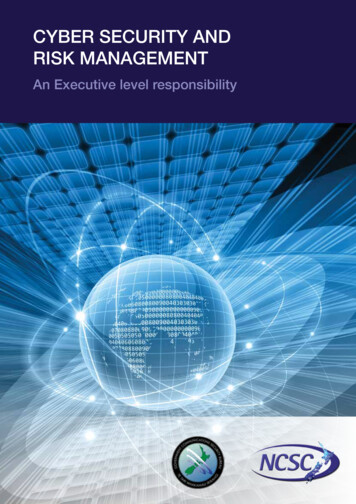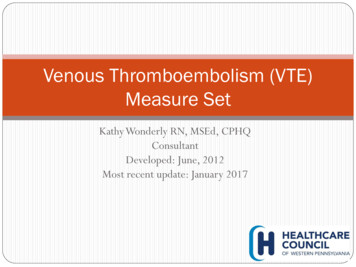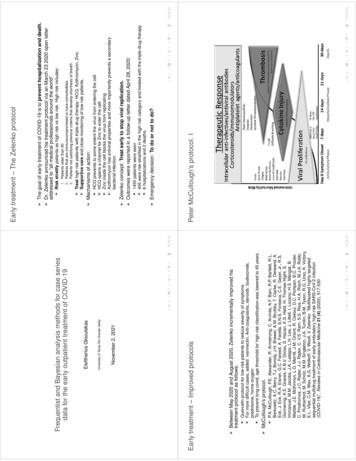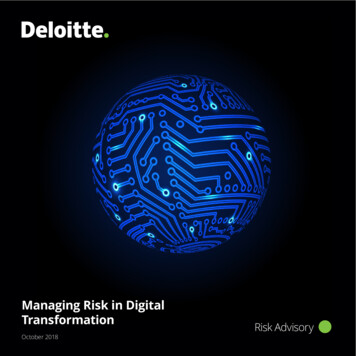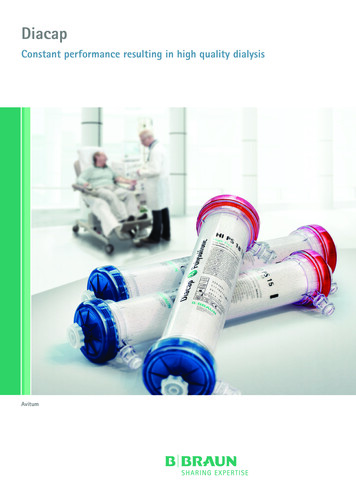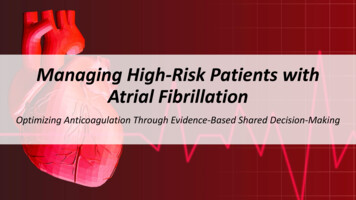
Transcription
Managing High-Risk Patients withAtrial FibrillationOptimizing Anticoagulation Through Evidence-Based Shared Decision-Making
This educational activity is sponsored byPostgraduate Healthcare Education,LLC and supported by an educationalgrant from Bristol-Myers Squibb and thePfizer Alliance
FacultyBarbara S. Wiggins, PharmD, BCPS,CLS, FNLA, FAHA, FCCP, AACCAffiliate ProfessorUniversity of South Carolina College of PharmacyClinical Pharmacy Specialist, CardiologyMedical University of South CarolinaCharleston, SCDr. Wiggins is a Clinical Pharmacy Specialist in Cardiology at the MedicalUniversity of South Carolina. She is also Affiliate Professor at the University of South Carolina College of Pharmacy.She received her BS in Pharmacy from St. Louis College of Pharmacy and her PharmD from Virginia CommonwealthUniversity/Medical College of Virginia in Richmond, Virginia. Dr. Wiggins has attained Board Certification inpharmacotherapy, critical care, and cardiology. She has also been named Fellow of the American Heart Association,National Lipid Association, American College of Clinical Pharmacy, and American College of Cardiology. She servesas a reviewer for Pharmacotherapy, British Medical Journal, European Medical Journal, and Journal of ClinicalLipidology and serves on the editorial board of the American Journal of Cardiovascular Drugs. She also currentlyserves on various committees for the American College of Cardiology.
DisclosuresDr. Wiggins states that she has no relevant affiliation or financial relationship or relationship toproducts or devices with a commercial interest related to the content of this activity todisclose.The clinical reviewer, Kyle A. Davis, PharmD, states he has no relevant affiliation or financialrelationship or relationship to products or devices with a commercial interest related to thecontent of this activity to disclose.Susanne Batesko, RN, BSN, Robin Soboti, RPh, and Susan R. Grady, MSN, RN-BC, as well as theplanners, managers, and other individuals, not previously disclosed, who are in a position tocontrol the content of Postgraduate Healthcare Education (PHE) continuing education activitieshereby state that they have no relevant conflicts of interest and no financial relationships orrelationships to products or devices during the past 12 months to disclose in relation to thisactivity. PHE is committed to providing participants with a quality learning experience and toimprove clinical outcomes without promoting the financial interests of a proprietary business.
AccreditationPostgraduate Healthcare Education,LLC is accredited by the AccreditationCouncil for Pharmacy Education as aprovider of continuing pharmacyeducation.UAN: 0430-0000-20-023-H01-PCredits: 1.25 hour (0.125 CEU)Type of Activity: Application
Objectives Describe evidence for anticoagulant selection in high-risk atrialfibrillation (AF) subpopulations, including older patients, those with ahistory of stroke, those with renal dysfunction, and those undergoingpercutaneous coronary intervention (PCI) Recognize the need to use the HAS-BLED score to identify and addressmodifiable risk factors for bleeding Discuss the benefits and drawbacks of various anticoagulant options inpatients with AF, including monitoring requirements, drug interactions,and bleeding risk Formulate individualized, evidence-based anticoagulation plans forpatients with AF using a shared decision-making process
Background: Atrial Fibrillation Affects 2.7 to 6.7 million patients in the United States (U.S.) Affects 33.5 million globally Risk increases with age Frequently seen with comorbidities Major cause of stroke ( 125,000/year) Risk of stroke is 5 times higher in patients with AF Most common arrhythmia requiring hospitalizationAlkhouli M, et al. J Am Coll Cardiol. 2018;71(24):2790-801.; Du X, et al. J Am Coll Cardiol. 2017;69(15):1968-82.;January CT, et al. J Am Coll Cardiol. 2014;64(21):e1-76.; Lip GYH, et al. Nat Rev Dis Primers. 2016;2:16016.
Risk Factors for Stroke
Risk Factors for StrokeNon-modifiable Age Gender Race Family historyCHC, combined hormonal contraceptive;PAD, peripheral artery disease.Modifiable Hypertension Diabetes Smoking Dyslipidemia Atrial fibrillation CHC use Obesity Heart failure PADGoldstein LB, et al. Stroke. 2011;42(2):517-84.
Risk Stratification – Stroke Risk ScoringCHA2DS2-VAScRisk factorScoreCHF or LVEF 40%1Hypertension1A2ge 75 r disease1Age 65-74 years1Scex category1CHF, congestive heart failure;LVEF, left ventricular ejection fraction;TIA, transient ischemic attack.Maximum of 9Pisters R, et al. Chest. 2010;138(5):1093-100.
Age Framingham Study Risk of stroke due to AF increased with each subsequent decade of life 50-59 years old: 1.5%60-69 years old: 2.8%70-79 years old: 9.95%80-89 years old: 23.5% Atrial Fibrillation Investigators Risk of stroke: 65 years old: 1% per year 65-75 years old: 4.3% 75 years old: 3.5% ATRIA Cohort Risk of stroke: 65-74 years old: 1.57 thromboembolic events/100 person-years 65 years old: 0.64 thromboembolic events/100 person-years Lane DA, et al. Thromb Haemost. 2009;101(5):802-5.;Poli D, et al. Thromb Haemost. 2009;101(5):938-42.
Vascular DiseaseRisk of hospital admission and death due to thromboembolism in patientswith AF 1 year: non-significant, HR 0.97 (95% CI 0.3-3.011, p 0.96) 5 years: significant, HR 2.04 (95% CI 1.29-3.22, p 0.002) 10 years: significant, HR 2.22 (95% CI 1.49-3.30, p 0.0001)CI, confidence interval;HR, hazard ratio.Conway DSG, et al. Am J Cardiol. 2004;93(11):1422-5.;Petersen P, et al. Arch Intern Med. 1990;150(4):819-21.;Siu CW, et al. Chest. 2007;132(1):44-9.
Sex Category Study by Poli D, et al evaluated 780 patients with AF on OAC Stroke rate: Males: 1.2 x 100 patient-years Females: 2.43 x 100 patient-years After correction for age: p 0.009 Other findings: Females had greater disability Females had more severe and more fatal strokes than males RR 3.1 (95% CI 1.3-6.5; p 0.001)OAC, oral anticoagulation; RR, relative risk.Lane DA, et al. Thromb Haemost. 2009;101(5):802-5.;Poli D, et al. Thromb Haemost. 2009;101(5):938-42.
cScore 0 in men or 1 in women Score 1 in men or 2 in women Score 2 in men or 3 in womenFor patients with AF (exceptwith moderate-to-severemitral stenosis or amechanical heart valve), anda CHA2DS2-VASc score of 0 inmen or 1 in women, it isreasonable to omitanticoagulant therapyFor patients with AF (exceptFor patients with AF whowith moderate-to-severehave a CHA2DS2-VASc score ofmitral stenosis or a2 or greater in men or 3 ormechanical heart valve),greater in women, oralprescribing an oralanticoagulation isanticoagulant to reducerecommendedthromboembolic stroke riskmay be consideredJanuary CT, et al. Circulation. 2019;140(2):e125-51.
Choosing When to AnticoagulateThromboembolic event risk000.6%1NoMaytherapy 710.8%812.2%9Anticoagulation recommendedFriberg L, et al. Eur Heart J. 2012;33(12):1500-10.;January CT, et al. Circulation. 2019;140(2):e125-51.
Bleed Risk
HAS-BLED ScoreHAS-BLEDHypertension1Abnormal renal orScorehepatic function11Bleeding risk (% bleeds per 100patient-years)Stroke10-1Low risk (1.1%)Bleeding12Intermediate risk (1.9%)Labile INR*1 3High risk (4.9%)Elderly ( 65 years old)1Drugs or11alcohol use*unstableor poor time in range ( 60%)use of antiplatelet agents, aspirin, nonsteroidal anti-inflammatory, etc. concomitantINR, international normalized ratio.Pisters R, et al. Chest. 2010;138(5):1093-100.
HAS-BLED Score A simple calculation that should be incorporated into clinicalpractice HAS-BLED is a better predictor of major bleeding than otherbleeding risk scores HAS-BLED 3 is indicative of a high risk for bleeding Should not be used on its own to determine anticoagulation Helps to identify patients who need closer/more careful management Control modifiable risk factors (hypertension, labile INRs)
Choosing an Anticoagulant
Types of Atrial FibrillationClassifications of Atrial FibrillationParoxysmalPersistent( 7 days)( 7 days)Long-standingpersistent( 12-monthduration)PermanentNonvalvularJanuary CT, et al. Circulation. 2014;130(23):2071-104.
New Oral Anticoagulants for StrokePrevention in Non-Valvular AFWarfarin1954Dabigatran RE-LY2010Apixaban ARISTOTLE2011Rivaroxaban ROCKET AF2012201320142015Edoxaban ENGAGE AF TIMI 48
Pharmacokinetic Properties of ulationtargetFactor IIFactor XaFactor XaFactor XaImpact oncoagulation assayaPTT (2-3 x)INR 40% aPTT 40%INR 40% aPTT & INR aPTTTime to peak (hours)1-32-41-31-2Half-life (hours)14-179-138-15 10% renal elimination80%66%25%50%DialyzableYesNoNoNoCYP metabolismNo30% CYP3A415% CYP3A4 4%P-glycoproteinsubstrate?YesYesYesYesaPTT, activated prothrombin time; CYP, cytochrome P450; DOAC, direct oral anticoagulant.Garcia D, et al. Blood. 2010;115(1):15-20.;Wittkowsky A. Pharmacotherapy. 2011;31(12):1175-91.
Choosing an Anticoagulantin Special Populations
High-Risk Patient Groups Elderly Prior history of stroke Triple therapy Renal dysfunction
Elderly
High-Risk Patients: The Elderly Elderly Increasing population Number of people 80 years old is expected to reach 25 millionby 2050 Increased age brings an increase in chronic diseases Many older adults live healthy, active lives Many are likely undertreated Lack of adequate representation in clinical trials Concern for overall risk (frailty, end organ dysfunction)
High-Risk Patients: The ElderlyPrevalence of AF: Most common arrhythmia in those 65 years old 10% of people over age 80 have AF 70% of patients with AF are between 65 and 85 years old Primary reason for anticoagulation: stroke prevention Strokes secondary to AF have high morbidity and mortalityGo AS, et al. JAMA. 2001;285(18):2370-5.;Kistler PM, et al. J Am Coll Cardiol. 2004;44(1):109-16.
High-Risk Patients: The Elderly and WarfarinStudyType (N)Patient ageComparisonPrimaryoutcomeBAFTARCT (973) 75 yearsWarfarin vs.ASA 75 mgStroke/SEE/ICH RR 0.48 (CI0.28-0.80)1.9 vs. 2%(p 0.90)WASPORCT (75) 80 yearsWarfarin vs.ASA 300 mgDeath, TE,bleeding25% vs. 44%(p 0.11)0 vs. 0.77%Wolff et alRetrospective(561) 85 yearsWarfarin vs.antiplatelet vs.PLCStrokeOR withwarfarin 0.53(CI 0.22-1.28)SPAFIIPost-hoc(385) 75 yearsWarfarin vs.ASA 325 mgStroke3.6% vs. 4.8%(p 0.39)Patti et alRetrospective(505) 85 yearsWarfarin vs.antiplatelet vs.PLCStroke/TIA/SEEOR 0.64(CI 0.24-1.69;p 0.37ASA, acetylsalicyclic acid (aspirin); ICH, intracerebral hemorrhage; OR, odds ratio; PLC, placebo;RCT, randomized controlled trial; SEE, systemic embolic event; TE, thromboembolism.ResultsBleeding4.0 % vs. 4.2%(p 0.77)
High-Risk Patients: The Elderly and DOACsStudyType (N)Patient Post hoc( 75 years: 1898; 85 years: 366) 75 yearsApixaban vs.antiplateletStroke, SEE 75 years: HR 0.33(CI 0.19-0.54) 85 years: HR 0.14(CI 0.02-0.48) 75 years: 2.6% vs.2.2% (p 0.50) 85 years: 4.7% vs.4.9% (p 0.93)RE-LYPost hoc(7258) 75 yearsDabigatran 110 mg vs.dabigatran 150 mg vs.warfarinStroke, SEE110 mg: HR 0.88 (CI0.66-1.17)150 mg: HR 0.67 (CI0.49-0.9)110 mg: 4.4% vs.150 mg: 5.1% vs.warfarin: 4.4%(p 0.89; p 0.07)ROCKET AFPost hoc(75-84 years:5566; 85 years:663) 75 yearsRivaroxaban 20 mg vs.warfarinStroke, SEEHR 0.80 (CI 0.63-1.02)4.9% vs. 4.4%HR 1.11 (CI 0.92-1.34)ARISTOTLEPost hoc(2396) 75 yearsApixaban 5 mg vs.warfarinStroke, SEEHR 0.71 (CI 0.53-0.95)3.3% vs. 5.2%(p 0.05)ENGAGE AFPost hoc(8474) 75 yearsEdoxaban 60 mg vs.warfarinStroke, SEEHR 0.83 (CI 0.66-1.04)4% vs. 4.8% (p 0.05) 85 years
Efficacy/Safety: Adults 75 Years OldMeta-analysisStroke/SEMajor bleedingSE, systemic embolism. Subgroup analysis of ARISTOPHANES study Compare risk of stroke/SE and major bleeding in very old(DOACs vs. warfarin) Apixaban Dabigatran RivaroxabanHR 0.58 (CI 0.49-0.69)HR 0.77 (CI 0.65-0.85)HR 0.6 (CI 0.54-0.67)p 0.001p 0.045p 0.001 Apixaban Dabigatran RivaroxabanHR 0.60 (0.54-0.67)HR 0.92 (0.78-1.07)HR 1.16 (1.07-1.24)p 0.001p 0.281p 0.001Deitelzweig S, et al. J Am Geriatr Soc. 2019;67(8):1662-71.
High-Risk Patients: Very Elderly National Health Insurance Research Database in Taiwan Risk of ischemic stroke and ICH in patients 90 years of age Warfarin versus DOACs DOACs lower risk of ICH 00.42%/year vs. 1.63%/yearChao TF, et al. Circulation. 2018;138(1):37-47.
Patients with Prior Stroke
High-Risk Patients: Prior Stroke Prosper Study Evaluated the effectiveness of DOACs vs. warfarin after ischemicstroke in patients with AF Cohort included patients 65 years old and anticoagulation naïve Primary outcome Home time and MACEGWTG, Get With The Guidelines stroke registry;MACE, major adverse cardiovascular events.Xian Y, et al. JAMA Neurol. 2019;76(10):1192-202.
High-Risk Patients: Prior Stroke Results 11,662 survivors of acute ischemic stroke 34.7% discharged on DOACs (warfarin, 65.3%) Patients discharged on DOAC had: More days at home 287.2 vs. 263 days Fewer deaths HR 0.88 (CI 0.82-0.9); p 0.001 Fewer all-cause readmissions HR 0.93 (CI 0.88-0.97); p 0.003 Fewer cardiovascular admissions HR 0.92 (CI 0.86-0.99); p 0.02 More gastrointestinal bleeding HR 1.14 (CI 1.01-1.30); p 0.03Xian Y, et al. JAMA Neurol. 2019;76(10):1192-202.
High-Risk Patients: Prior Stroke Conclusions The utilization of a DOAC was associated with better long-termoutcomes than warfarinXian Y, et al. JAMA Neurol. 2019;76(10):1192-202.
Patients on Dual AntiplateletTherapy (DAPT)
High-Risk Patients: The Triple Therapy ThreatTriple Therapy Threat Patients require DAPT (aspirin P2Y12 inhibitor) and have anindication for systemic anticoagulation Approximately 5% to 10% of patients undergoing PCI have anindication for chronic anticoagulation Various strategies have been evaluatedFaxon DP, et al. Thromb Haemost. 2011;106(4):572-84.
WOEST Trial: What is the Optimal Antiplatelet andAnticoagulant Therapy in Patients with Oral Anticoagulationand Coronary StentingObjectiveEvaluate the safety and efficacy of clopidogrel alone comparedwith clopidogrel plus aspirin in patients with an indication forOAC and s/p PCITrial designOpen-label, multicenter, randomized 1:1 ratio, controlled trialOutcomesPrimary: occurrence of any bleeding within 1 year of PCISecondary: composite of death, MI, stroke, stent thrombosis,and target-vessel revascularizationMI, myocardial infarction.Dewilde WJM, et al. Lancet. 2013;381(9872):1107-15.
WOEST Trial: Inclusion and Exclusion Criteria Inclusion criteria: Age 18 years Indication for OAC for at least 1 year At least 1 coronary lesion with an indication for PCI Exclusion criteria: History of intracranial bleedingCardiogenic shockPeptic ulcer disease in the past 6 monthsThrombocytopenia (platelets 50,000)Major bleeding within the past yearAge 80 yearsDewilde WJM, et al. Lancet. 2013;381(9872):1107-15.
WOEST Trial: Primary Endpoint - BleedingDewilde WJM, et al. Lancet. 2013;381(9872):1107-15.
WOEST Trial: Primary Endpoint - BleedingDAPT (n 279)TAT (n 284)p-valueAny bleeding event54 (19.4%)126 (44.4%) 0.0001TIMIMajorMajor and minor9 (3.2%)39 (14%)16 (5.6%)89 (31.3%)0.159 0.0001GUSTOSevereSevere and moderate4 (1.4%)15 (5.4%)10 (3.5%)35 (12.3%)0.1190.003BARC322 3118 (6.5%)23 (8.2%)40 (14.3%)18 (6.5%)36 (12.7%)59 (20.8%)90 (31.7%)45 (15.8%)0.011 0.0001 0.00010.0004Any blood transfusion11 (3.9%)27 (9.5%)0.011BARC, Bleeding Academic Research Consortium; GUSTO, Global Strategies for Opening OccludedCoronary Arteries; TAT, triple anticoagulant therapy; TIMI, thrombolysis in myocardial infarction.Dewilde WJM, et al. Lancet. 2013;381(9872):1107-15.
WOEST Trial: Secondary thMITVRDual TherapyST, stent thrombosis; TVR, target-vessel revascularization.StrokeSTTriple TherapyDewilde WJM, et al. Lancet. 2013;381(9872):1107-15.
WOEST Trial: Conclusions First randomized trial to address optimal antiplatelet therapy in patients on OACundergoing coronary stenting Specifically designed to evaluate bleeding events Primary endpoint: Dual therapy with OAC plus clopidogrel resulted in less bleedingthan triple therapy Secondary endpoint: With dual therapy, there was no excess ofthrombotic/thromboembolic events (stroke, stent thrombosis, target vesselrevascularization, MI, or death )Dewilde WJM, et al. Lancet. 2013;381(9872):1107-15.
PIONEER AF – PCI: An Open-Label, Randomized, Controlled, Multicenter StudyExploring Two Treatment Strategies of Rivaroxaban and a Dose-Adjusted OralVitamin K Antagonist Treatment Strategy in Subjects With Atrial Fibrillation WhoUndergo Percutaneous Coronary InterventionDesign:Patients (n 2124) with AF and PCI were randomized to: Group 1: Rivaroxaban 15 mg daily plus P2Y12 inhibitor for 12 months (n 709) Group 2: Rivaroxaban 2.5 mg twice daily plus DAPT for 1-12 months (n 709) Group 3: Warfarin plus DAPT for 1-12 months (n 706)Results:26.7%16.8%18%Clinically significant bleeding: 16.8% in Group 1 18% in Group 2 26.7% in Group 3(HR 0.59, p 0.001 for group 1 vs. 3, ARR 9.9, NNT 11)(HR 0.63, p 0.001 for group 2 vs. 3, ARR 8.7, NNT 12)Group 1: Rivaroxaban 15 mg daily, P2Y12 for 12 monthsGroup 2: Rivaroxaban 2.5 mg daily, DAPT for 1-12 monthsARR, absolute risk reduction; NNT, number needed to treat.Gibson CM, et al. N Engl J Med. 2016;375(25):2423-34.Group 3: Warfarin, DAPT for 1-12 months
PIONEER AF – PCISecondary Outcomes: MACE (composite and alone) and stent thrombosis Stent thrombosis: 0.8% in group 1 vs. 0.9% in group 2 vs. 0.7% in group 3(HR 1.20, p 0.79 for group 1 vs. 3; HR 1.44, p 0.57 for group 2 vs. 3) MACE: 6.5% in group 1 vs. 5.6% in group 2 vs. 6% in group 3(HR 1.08, p 0.75 for group 1 vs. 3; HR 0.93, p 0.76 for group 2 vs. 3)Conclusion:In patients with AF undergoing PCI w/ stents, Rivaroxaban 15 mg daily plus P2Y12 monotherapy for 1 year or Rivaroxaban 2.5 mg BID plus 1, 6, or 12 months of DAPTreduced the risk of clinically significant bleeding compared to VKA plus 1, 6, or 12months of DAPTBID, twice daily; VKA, vitamin K antagonist.Gibson CM, et al. N Engl J Med. 2016;375(25):2423-34.
RE-DUAL PCI: Dual Antithrombotic Therapy with DabigatranAfter Percutaneous Coronary Intervention in Patients withAtrial FibrillationDesign:Patients (n 2725) with AF undergoing coronary revascularization wererandomized to: Dual therapy with dabigatran 110 mg (n 981) Dual therapy with dabigatran 150 mg (n 763) Triple therapy with warfarinResults:Major or CRNM bleeding events: 15.4% of the dual therapy with dabigatran 110 mg group 26.9% of the triple therapy group(p for non-inferiority 0.001, p for superiority 0.001)Major or CRNM bleeding events: 20.2% of the dual therapy with dabigatran 150 mg group 25.7% of the corresponding triple therapy group (excluding elderlyparticipants outside the U.S.)(p for non-inferiority 0.001)CRNM, clinically relevant non-major.Dual therapy with dabigatran 110 mgTriple therapyCannon CP, et al. N Engl J Med. 2017;377(16):1513-24.
RE-DUAL PCIEfficacy endpoint: composite of MI, stroke, systemic embolism 13.7% dual therapy vs. 13.4% triple therapyHR 1.04 (CI 0.84-1.29), p 0.005 for non-inferiorityConclusions:In patients with AF who have undergone PCI, Dual therapy with dabigatran P2Y12 antagonist significantly reducedthe risk of bleeding compared to warfarin triple therapy, with noninferiority for overall thromboembolic events Absolute risk reductions with dabigatran dual therapy were 11.5% and5.5% in ISTH major or CRNM bleeding at the 110 mg and 150 mg doses,respectively, compared with warfarin triple therapyISTH, International Society on Thrombosis and Haemostasis.Cannon CP, et al. N Engl J Med. 2017;377(16):1513-24.
AUGUSTUS TRIAL: Antithrombotic Therapy afterAcute Coronary Syndrome or PCI in Atrial FibrillationObjectiveTrial designOutcomesAssess the safety and efficacy of apixaban aspirin compared toVKA aspirin or PLCProspective, multicenter, two-by-two factorial, RCTPrimary: ISTH major or CRNM bleedingSecondary: stroke, MI, stent thrombosis, urgentrevascularizationLopes RD, et al. N Engl J Med. 2019;380(16):1509-24.
AUGUSTUS TRIALRandomizen 4614patientsApixaban 5 mg BID P2Y12 inhibitorApixaban 2.5 mg BID in selectedpatientsOpenlabelVKA P2Y12 inhibitor(INR 2-3)ASA for all on the day of ACS or PCIASA versus PLC after randomizationAspirinDoubleblindACS, acute coronary syndrome.PlaceboAspirinDoubleblindPlaceboLopes RD, et al. Am Heart J. 2018;200:17-23.
AUGUSTUS TRIAL: Baseline CharacteristicsTotal (N 4614)Total (N 4614)70.7 (64.2, 77.2)Age, median (25th, 75th), years70.7 (64.2, 29.077.2)Age, median (25th, 75th), yearsFemale, %CHA2DS2-VASc score, mean (SD)29.03.9 (1.6)Female, %HAS-BLED score, mean (SD)2.9 (0.9)CHA2DS2-VASc score, mean3.9 (1.6)Prior (SD)OAC, %49.0P2Y12 inhibitor, %HAS-BLED score, mean (SD)2.9 (0.9)ClopidogrelPrior OAC, %49.0 92.6Prasugrel1.1P2Y12 inhibitor, %Ticagrelor6.2Number of days from ACS/PCI toClopidogrel92.66.6 (4.2)randomization, mean (SD)Prasugrel1.1Qualifying index event, %ACS and PCITicagrelor6.2 37.3ACS and no PCI23.9Lopes RD, et al. N Engl J Med.Numberof days from ACS/PCItoPCI2019;380(16):1509-24.Elective38.8
AUGUSTUS TRIAL: Major/CRNM Bleeding2018Apixaban placebovs. VKA aspirin:ARR: 11.4% (NNT 9)18.7161413.8121010.987.36420Major/CRNM bleedingVKA ASAApixaban ASAVKA PlaceboApixaban PlaceboLopes RD, et al. N Engl J Med. 2019;380(16):1509-24.
AUGUSTUS TRIAL: Ischemic Outcomes –Apixaban vs. VKAApixaban(N 2306)VKA(N 2308)HR(95% CI)Death/ischemic events (%)6.77.10.93 (0.75–1.16)Death (%)3.33.21.03 (0.75–1.42)Cardiovascular death (%)2.52.31.05 (0.72–1.52)Stroke (%)0.61.10.50 (0.26–0.97)Myocardial infarction (%)3.13.50.89 (0.65–1.23)Definite or probable stentthrombosis (%)0.60.80.77 (0.38–1.56)Urgent revascularization (%)1.71.90.90 (0.59–1.38)Hospitalization (%)22.526.30.83 (0.74–0.93)EndpointLopes RD, et al. N Engl J Med. 2019;380(16):1509-24.
AUGUSTUS TRIAL: EndpointsEndpointsApixabanWarfarinp-valueMajor or CRNM bleeding241/2290 (10.5%)332/2259 (14.7%) 0.001Death or hospitalization541/2306 (23.5%)632/2308 (27.4%)0.002Death or ischemic event154/2306 (6.7%)163/2308 (7.1%)NSEndpointsAspirinPlacebop-valueMajor or CRNM bleeding367/2277 (16.1%)204/2279 (9.0%) 0.001Death or hospitalization604/2307 (26.2%)569/2307 (24.7%)NSDeath or ischemic event149/2307 (6.5%)168/2307 (7.1%)NTNS, not significant; NT, not tested.Lopes RD, et al. N Engl J Med. 2019;380(16):1509-24.
AUGUSTUS TRIAL: Conclusions In patients with AF and recent ACS or PCI treated with a P2Y12 inhibitor,OAC regimen that included apixaban, without aspirin, resulted in lessbleeding and fewer hospitalizations without significant differences inischemic events than regimens that included a VKA, aspirin, or both Largest trial available Stroke and bleeding risks were assessed Percentage of time in therapeutic INR was lower than other DOAC PCItrials Majority of patients were placed on clopidogrelLopes RD, et al. N Engl J Med. 2019;380(16):1509-24.
DAPT vs. TAT: Guideline Recommendation ACC/AHA Guidelines If TAT is used, it may be reasonable to choose clopidogrel overprasugrel DAPT with a P2Y12 inhibitor (clopidogrel or ticagrelor) and doseadjusted VKA, rivaroxaban 15 mg daily, or dabigatran 150 mg twicedaily is reasonable If TAT is used, then transition to DAPT may be considered at 4 to 6weeks of TATACC, American College of Cardiology;AHA, American Heart Association.January CT, et al. Circulation. 2019;140(2):e125-51.
Valgimigli M, et al. Eur Heart J. 2018;39(3):213-60.
Patients with RenalInsufficiency
Renal Insufficiency AF is more common in patients with ESRD onhemodialysis than in the general population Prevalence of 11%-13% Increased risk of stroke and bleeding amongpatients with AF and ESRD 1.5-fold increase in stroke 2-fold increase in bleedingESRD, end-stage renal disease.Wang TK, et al. Heart Lung Circ. 2016;25(3):243-9.
Pharmacokinetic Properties of ulationtargetFactor IIFactor XaFactor XaFactor XaImpact oncoagulation assayaPTT (2-3 x)INR 40% aPTT 40%INR 40% aPTT & INR aPTTTime to peak (hours)1-32-41-31-2Half-life (hours)14-179-138-15 10% renal elimination80%66%25%50%DialyzableYesNoNoCYP metabolismNo30% CYP3A415% CYP3A4 4%P-glycoproteinsubstrate?YesYesYesYesGarcia D, et al. Blood. 2010;115(1):15-20.;Wittkowsky A. Pharmacotherapy. 2011;31(12):1175-91.
Renal Dosing of DOACsIndicationApixabanDabigatranNon-valvular AFReduce dose to 2.5mg BID (2 of 3criteria: SCr 1.5mg/dL, age 80years, weight 60kg)Reduce dose to 75mg BID if CrCl 1530 mL/min;avoid use if CrCl 15 mL/minAvoid use if CrCl Reduce dose to 1595 mL/min;mg daily if CrCL reduce dose to 30 30-50 mL/minmg daily if CrCl 1550 mL/minVTE treatmentNo dose reductionAvoid if CrCl 30mL/minReduce dose to 30mg daily if CrCl 15-50 mL/min orweight 60 kg;avoid use if CrCl 15 mL/minCrCl, creatinine clearance; SCr, serum creatinine; VTE, venous thromboembolism.EdoxabanRivaroxabanAvoid use if CrCl 30 mL/min
RENAL AF: Renal Hemodialysis Patients AllocatedApixaban versus Warfarin in Atrial FibrillationObjectiveTrial designEndpointsPK, pharmacokinetics.Assess the safety of apixaban versus warfarin with respect tomajor bleeding or CRNM bleeding in patients with AF and withESRD on hemodialysisOpen-label, randomized trialPrimary: ISTH major or CRNM bleedingSecondary: PK in patients randomized to apixaban: death,stroke, or systemic embolismPokorney SD. AHA 2019 Scientific Sessions, Philadelphia, PA. November 16, 2019.
RENAL AF Inclusion criteria: Atrial fibrillationCHA2DS2-VASC 2HemodialysisCandidate for OAC Exclusion criteria: Moderate to severe mitral stenosisAnticoagulation for other reasons than AFNeed for aspirin dose 81 mgDAPTPokorney SD. AHA 2019 Scientific Sessions, Philadelphia, PA. November 16, 2019.
RENAL AFRandomizen 154patientsApixaban 5 mg BIDWarfarinApixaban 2.5 mg BID in selected patientsN 82(INR 2-3)N 72Pokorney SD. AHA 2019 Scientific Sessions, Philadelphia, PA. November 16, 2019.
RENAL AF: Baseline CharacteristicsApixaban(N 82)Warfarin(N 72)696824 (29.3%)15 (20.8%)Female, n (%)34 (41.5%)22 (30.6%)Black, n (%)35 (42.7%)34 (47.2%)44Stroke, n (%)17 (20.7%)12 (16.7%)Warfarin or DOAC naive, n (%)10 (12.2%)5 (5.6%)Type of AF, n (%) Paroxysmal Persistent/permanent45 (54.9%)37 (45.1%)40 (55.6%)32 (44.4%)Aspirin, n (%)29 (36.7%)32 (45.7%)Prior clinically relevant bleeding, n (%)18 (22.0%)14 (19.4%)Age (median), years 75 years, n (%)CHA2DS2-VASc, mean
RENAL AF: CharacteristicsRandomized to apixabanApixaban (n 77)First apixaban dose2.5 mg twice daily22 (28.6%)5 mg twice daily55 (71.4%)Apixaban dose reduced from 5 mg to 2.5 mg twice daily15 (27.3%)Patients randomized to warfarinWarfarin (n 68)Time in therapeutic range (INR 2-3)44.3%Pokorney SD. AHA 2019 Scientific Sessions, Philadelphia, PA. November 16, 2019.
Time to Major or CRNM BleedingPokorney SD. AHA 2019 Scientific Sessions, Philadelphia, PA. November 16, 2019.
Apixaban(N 82)Warfarin(N 72)21 (25.6%)16 (22.2%)Intracranial1 (1.2%)1 (1.4%) Gastrointestinal2 (2.4%)6 (8.3%)11 (13.4%)6 (8.3%)ISTH major bleed7 (8.5%)7 (9.7%) Intracranial1 (1.2%)1(1.4%) Gastrointestinal2 (2.4%)5 (6.9%) Hemodialysis access site1 (1.2%)0 (0%)ISTH CRNM bleed14 (17.1%)9 (12.5%) Gastrointestinal0 (0%)1 (2.8%)10 (12.2%)6 (8.3%)ISTH major bleed/CRNM bleed Hemodialysis access site Hemodialysis access sitePokorney SD. AHA 2019 Scientific Sessions,Philadelphia, PA. November 16, 2019.RENAL AF: Primary Safety Endpoint
RENAL AF: Secondary EndpointApixaban(N 82)Warfarin(N 72)Stroke2 (2.4%)2 (2.8%) Ischemic1 (1.2%)2 (2.8%) Hemorrhagic1 (1.2%)6 (8.3%)0 (0%)0 (0%)21 (26.5%)13 (18.1%) Cardiovascular9 (11%)4 (5.6%) Non-cardiovascular5 (6.1%)8 (11.1%)Undetermined7 (8.5%)1 (1.4%)Bleeding-related death1 (1.2%)0 (0%)Systemic embolismDeathPokorney SD. AHA 2019 Scientific Sessions, Philadelphia, PA. November 16, 2019.
RENAL AF: Conclusions First randomized trial to assess the safety of a DOAC (apixaban)vs. warfarin for patients with AF and ESRD on hemodialysis Terminated prematurely and the power was limited by smallsample size In this exploratory study, there were similar rates of major andCRNM bleeding with apixaban and warfarin Large proportion of warfarin patients in subtherapeutic range Results: apixaban may be a reasonable anticoagulant choice inpatients on hemodialysisPokorney SD. AHA 2019 Scientific Sessions, Philadelphia, PA. November 16, 2019.
Anticoagulation: Striking a BalanceBenefitRisk
Anticoagulants: Select Drug ole, ketoconazole,nelfinavir, lopinavir/ritonavir,ritonavir, conivaptan*Avoid useDronederone, ketoconazole*Consider reducing thedabigatran dose to 75 mg BIDin the setting of mild renalimpairment (CrCl 30-50mL/min)*Avoid use if CrCl 30mL/minKetoconazole, itraconazole,voriconazole, ritonavir,clarithromycin*Decrease dose to 2.5 mg BIDor avoid concomitant use*If already on 2.5 mg doseand one of these agents isinitiated, discontinueapixabanCYP3A4 or P-gP inducers*Avoid useCYP3A4 or P-gP inducers*Avoid useEdoxabanAmiodarone, diltiazem,verapamil, quinidine,ranolazine, dronedarone,erythromycin, azithromycin*If CrCl 15-80 mL/min, avoiduseCYP3A4 or P-gP inducers*Avoid useP-gP, P-glycoprotein.CYP3A4 or P-gP inducers*Avoid useEliquis (apixaban) [prescribing information]. 2019.; Pradaxa (dabigatran) [prescribing information]. 2019.;Savaysa (edoxaban) [prescribing information]. 2019.; Xarelto (rivaroxaban) [prescribing information]. 2019. p
Dr. Wiggins is a Clinical Pharmacy Specialist in Cardiology at the Medical University of South Carolina. She is also Affiliate Professor at the University of South Carolina College of Pharmacy. . (PHE) continuing education activities hereby state that they have no relevant conflicts of interest and no financial relationships or





